
Sep 23 2022
7 min read

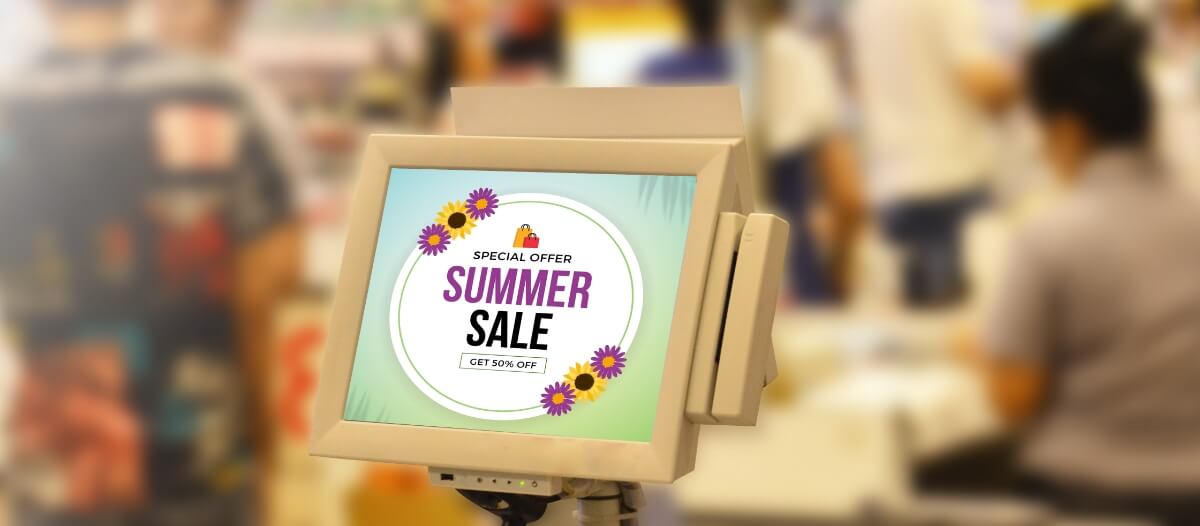
Jun
Running a business is no easy feat. You probably have a million and one problems to deal with—from marketing to logistics and operations. This takes up a massive chunk of time and energy, so you can’t focus on the more high-value aspects of your business. Frustrating, isn’t it?
Enter PoS (point of sale) systems, a sure-fire solution to tackling this problem. PoS display software empowers retailers to capture a buyer’s attention with eye-catching visuals, thus boosting sales and top-of-mind recall.
It has evolved from a basic cash register and shelf display into a power-packed dashboard of business solutions. In fact, retail businesses have been able to scale in the blink of an eye with PoS, boosting sales by almost 200%.
Point-of-sale (PoS) advertising refers to promotional activities, usually via digital displays near areas where transactions occur. These can typically be near checkout counters to capture consumers’ attention and influence their purchasing decisions at the final moment before purchase.
Some people use Point of Sale and Point of Purchase interchangeably, but they aren’t the same. PoS is where a customer pays for products (think cash registers). On the other hand, PoP is where customers make their purchasing decisions. You would have probably noticed PoS displays laden with discounted products in certain parts of your local grocery store. Coca-Cola is one brand known for its innovative PoS displays.
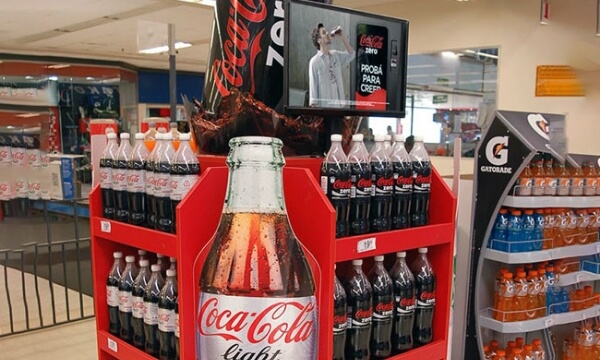
But how do you hit the mark with PoS advertising? It’s easy—embrace the digital revolution.
A wide array of digital PoS solutions allow you to display and promote your products. These are great at driving conversions for quicker business growth. This blog will discuss some innovative ways digital screens can boost your point of sale gains.
80% of grocers who have used digital signage in their stores have seen a boost in sales by nearly 33%. Additionally, it increases brand awareness by 47.7%. So, if you’re planning to upgrade your PoS systems, don’t forget to pair them with digital signage.
Here are four types of Point of Sale marketing that can add to your top-of-funnel strategies:
1.PoS advertisement displays
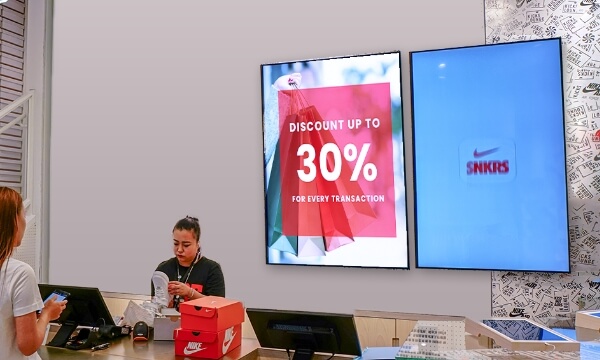
These digital promotional displays are designed for placement at the point of sale (PoS) in retail or service environments. Their primary purpose is to showcase products, offers, or information to consumers at the location where they finalize their purchases, such as checkout counters.
Think about it. Would you impulsively buy a phone worth $500 if you saw it on a PoS display? Probably not. But what if it’s an accessory for your phone that costs just $2? It’ll be in your cart in the blink of an eye. Pencil sharpeners, chocolates, lozenges, and buttons are a few other add-on items you can advertise for a similar result.
How It Works
PoS advertisement displays are strategically positioned to capture consumers’ attention during the crucial moments leading up to a transaction. They often feature eye-catching visuals, promotional messages, or interactive elements to engage customers. By leveraging the impulse-driven nature of consumers, these displays can:
Introduce new products or highlight existing ones.
Promote limited-time offers or discounts to encourage immediate purchases.
Provide product information or demonstrations to assist in the buying decision.
Enhance the overall shopping experience by offering relevant content or interactive features.
2. Product catalogs
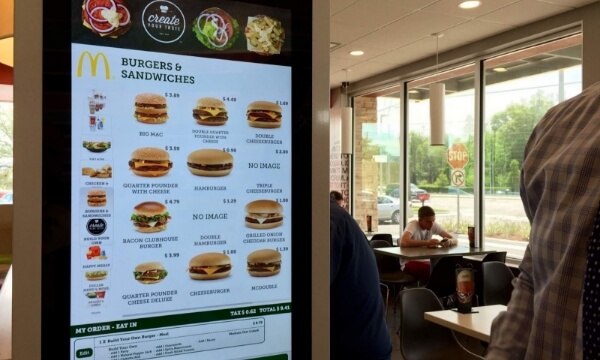
A product catalog is a structured collection or list of items a company offers for sale, often including detailed descriptions, images, prices, and other relevant information. It serves as a comprehensive guide for potential buyers, providing them with essential details about each product.
For example, you might browse a retailer’s digital product catalog online. As you navigate different sections, you can read about each product, see its images, check its price, and decide what to purchase. The catalog facilitates this process by presenting all the necessary information in an accessible manner.
How it works
Product catalogs are organized to make it easy for customers to browse and locate items. This can be by category, brand, price range, or other relevant criteria.
Images or graphics give customers a visual representation of the product, helping them understand its appearance, size, and sometimes functionality.
In digital catalogs, users can often search for specific products or use filters to narrow their choices based on specific criteria.
Digital catalogs might offer interactive features like zoom-in on images, 360-degree product views, or even augmented reality experiences.
Suggested Read: What to learn from McDonald's billion dollar investment in self-ordering digital signage?
3. Discounted products
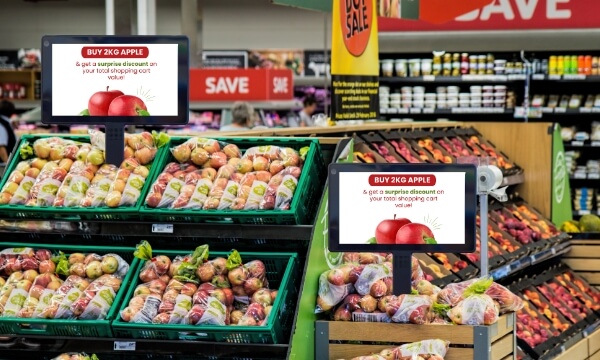
These refer to items offered for sale at a reduced price compared to their original or usual price. Discounts can be applied for various reasons, such as clearing out old inventory, promoting a new product, or incentivizing a purchase during a particular sales period.
Have you ever read a sign in the store that said, “X product, now 80% off!” and considered buying it even though you didn’t need it? 89% of customers named price a primary factor influencing their purchasing decisions. Trigger your consumer’s desire to purchase using PoS systems that display messages like “Hurry, only 2 items left!”. This will create a sense of urgency and FOMO among buyers.
How it works
Discounts are often available for a limited period, creating a sense of urgency for customers to purchase before the offer ends.
Offering discounted products primarily incentivizes purchases, increases sales volume, and attracts new customers.
Retailers offer discounts to compete with other businesses or to match or beat their prices.
4. Membership plans
These are structured programs or schemes offered by businesses or organizations where individuals can subscribe or enroll, often by paying a fee, to receive exclusive benefits, services, or access to specific content or areas. Membership plans are commonly used to foster customer loyalty, generate consistent revenue, or provide specialized services.
How it works
Members often receive exclusive perks, such as discounts, early access to products or events, specialized content, or premium services that non-members do not get.
Some membership plans offer different levels or tiers, each with benefits and corresponding price points. For example, a basic membership might offer limited features, while a premium membership provides full access.
Membership plans often provide channels for members to provide feedback, ensuring that the business can continually refine and improve the offerings based on member needs and preferences.
If you’re running into a brick wall every time you try to think of engaging PoS advertising and marketing strategies, you can use these four ideas as inspiration:
1. Gamify discounts to improve engagement
There are many ways you can use digital signage to play games. Say a new Marvel movie has come out, and you have Marvel-themed products. Hold a contest for buyers through quizzes and reveal a prize like a discount or a freebie. Offer instant rewards like a 25% discount on specific items, or a “Buy 2 get 1 Free deal” with the games.
Digital discounts are exciting ways to gamify promotional campaigns; they allow you to add QR codes to your digital displays. Customers can scan these QR codes to avail of a discount. These can be limited deals, randomized surprise discounts, or even fixed rebates.
Want to learn more about Digital Discounts? Head over to this page.
2. Display complementary products

Upsell your best-selling products by promoting complementary items on your PoS display. Take a yoga mat, for example. People who buy a yoga mat from you will probably be hunting for other fitness equipment.
Anticipate their needs and promote products they’re likely to buy—resistance bands, weights, track pants, and fitness trackers. This will help you sell more while marketing your store as a one-stop destination for your customer’s needs.
3. Make your PoS ads multilingual
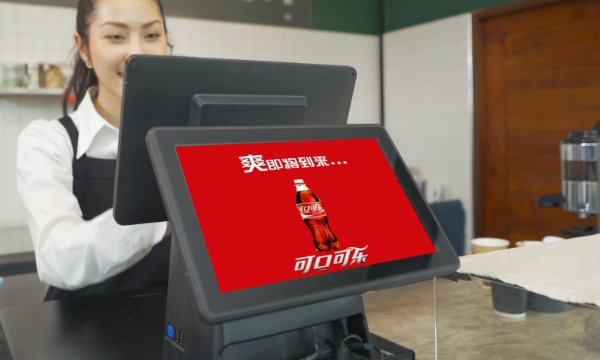
When you create multilingual POS ads, you can appeal to a wider consumer base and invoke a positive emotion in them. 68% of consumers would switch to a different brand that offers support in their native language.
While English is a standard mode of communication, most of us are more comfortable with our native language. Take advantage of this and create PoS solutions that can build long-lasting connections with your customers.
4. Deploy a social wall at the point of sale
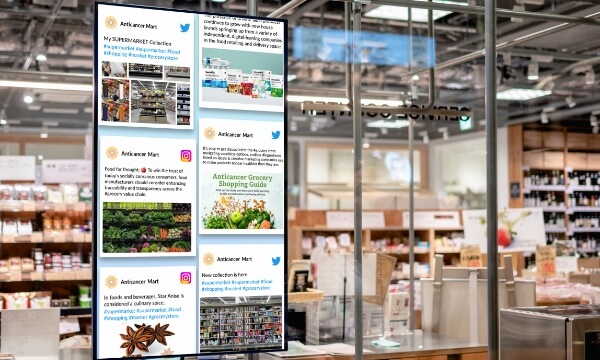
With a social wall, you’ll be able to collate various posts from your social media feeds and display them on digital screens. These are easily monetizable, too, as many brands will want to buy space on the wall to increase their visibility.
Another concept would be to include a selfie theme. Ask customers to take selfies of themselves and upload them on their social media accounts with your brand’s hashtag. You can then display these pictures on your social wall. This is a great way to build engagement in the store.
Launch cross-channel social media campaigns and leverage user engagement to boost sales. Try the Pickcel Social Wall solution for your business.
5. Entice customers with product testing booths
Set up a product testing booth in various parts of your store. This will improve brand awareness and lead to more conversions. To make your booth stand out, use digital signage solutions to draw attention to your selling products. Make sure the visuals have a clear call to action, so customers know they can avail free samples and discounts on certain products.
When they enter the booth, ask them to try the product and give feedback. If they provide constructive criticism, note it down for later, so you can re-evaluate your business strategy when the time comes.
6. Get in-depth insights with artificial intelligence
Retailers often use facial recognition technology to recognize shoppers by learning their profile, recent order history, buying traits, and more. AI-based PoS systems combined with facial recognition can allow retailers to identify a customer’s age, gender, and emotions.
The AI algorithms then assess these factors to display highly-targeted advertisements in point-of-sale areas. This helps personalize the user’s shopping experience and boosts the retailer’s sales.
70% of purchasing decisions are made at the PoS. As a retailer, your job is to capitalize on this by revamping your creative displays with modern digital signage displays. This can help you boost sales through a variety of ways:
Attract customers: Digital signage attracts the most attention from consumers. After all, a brightly coloured animation is definitely more engaging than a static image with text. By pairing digital signage with your PoS ads, you draw buyer attention to your products at the moment it matters most—just before they make a purchase.
Display dynamic content: Dynamic content refers to media that can be sourced without much prior planning― these may include user-generated content, syndicated content or information that can update automatically whenever there is new data available. With PoS advertising, you’re aiming to display promotional messages in the most engaging manner. Your priority is the buyer experience. Nothing else.
Multipurpose solution: No matter how creative your Point of Sale advertising displays are, they are ultimately serving you for one purpose: marketing and promotion. On the contrast, digital displays can serve you in more than one way. PoS digital signs can show marketing content, billing details, queue information, estimated wait time, entertainment content and whatnot.
Situation-based content update: Digital signage software simplifies content updates, eliminating long waits for changes. For example, if coffee sales surge, staff can quickly adjust the store’s PoS displays to promote related items like sugar, milk, mugs, and cookies, encouraging customers to make additional purchases.
While the retail sector has been the traditional stronghold for PoS advertising, many other industries are now utilizing its potential to elevate customer engagement and brand recall. Here are a few examples:
1. Restaurants
Beyond retail, eateries are emerging as prime venues for PoS displays. From self-service kiosks that streamline orders to digital menu boards that showcase daily specials, the restaurant industry is redefining customer interaction. Additionally, feedback stations allow patrons to share their dining experiences in real time, helping establishments refine their offerings.
2. Hotels
The hospitality sector is using PoS advertising to enhance guest experiences. While the reception and lobby remain focal points for promotions, other areas like in-house restaurants, spas, golf courses, and gaming lounges are also being tapped. Digital reader boards in lobbies can spotlight premium suite availability or upcoming events, while interactive restaurant displays might suggest wine pairings or chef’s specials.
Also Read : 7 hotel digital signage trends in 2023
3. Spas
Digital signage in spas is not just about promoting treatments, it is about crafting experiences. Vibrant displays can showcase customer testimonials, introduce seasoned therapists, or offer beauty and wellness tips. High-definition images can provide glimpses of serene treatment rooms or highlight the results of specific therapies.
4. Gyms and fitness centers:
These establishments increasingly use PoS displays to promote membership packages, showcase workout tutorials, or highlight members’ success stories. Interactive screens might offer nutritional advice, introduce trainers, or provide schedules for upcoming classes.
5. Cinemas and theaters:
The entertainment industry is also catching up. Cinemas can use PoS displays in ticketing areas to promote upcoming movies, offer combo deals on snacks, or even showcase behind-the-scenes content. Theater signage screens highlight upcoming plays, introduce cast members, or provide special package deals for season ticket holders
Evidently, Point of Sale advertising and marketing has taken various industries by storm with its uncanny ability to make customers buy more. But in the age of the internet, it’s important to remember traditional PoS systems aren’t enough—you need to upgrade them with digital signage solutions.
Not sure how to get started? Our team at Pickcel will be happy to help you draw up your PoS marketing strategy. Reach out to us here.
Take complete control of what you show on your digital signage & how you show it.
Take complete control of what you show on your digital signage & how you show it.
Start Free Trial Schedule My Demo
Sep 23 2022
7 min read
![What are 3D digital billboards for advertising? [5 Examples]](/blog/images/3d-advertising-billboard/banner_hu3a52995533a2f5f6af3321531a883f0d_86539_700x0_resize_q75_box.jpg)
Sep 8 2022
6 min read
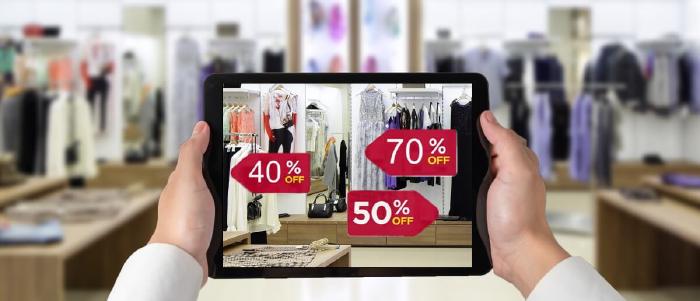
Sep 6 2022
10 min read

Aug 18 2022
6 min read